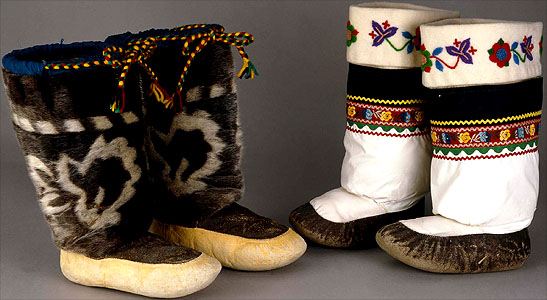
beautyme collections culture cuisine motor music search

Annuraaq: Arctic Clothing from Igloolik
15 February - 27 May 2001
The English word anorak comes from annuraaq, meaning "a piece of clothing" in the language of the Inuit of the Canadian Arctic.
Like other forms of Inuit technology, Inuit clothing fascinates by its apparently simple design and great effectiveness. This exhibition focuses on the clothing made by the people of Igloolik, an Inuit community of about 1300 people some 200 miles north of the Arctic Circle. It is situated in Nunavut ('our land'), the largest self-governing territory of Canada.
Established in 1999, Nunavut has a population of about 27,000 (85% Inuit) in an area covering 20% of the Canadian land mass. In Igloolik, where temperatures are above freezing only in June, July and August, warm clothing is of vital importance. This is particularly so for men who spend many hours outside fishing, and hunting seals, walrus, whales and caribou. Traditional Inuit skin clothing is well suited to this purpose, being designed to capture air warmed by the body. In winter, when hunting or travelling, two layers of clothing are worn. The inner layer has the fur turned inwards towards the body, while the fur of the outer layer is turned outwards. Warm air is thus trapped between the two layers of clothing and the body, providing highly effective insulation against the cold.
In Igloolik, caribou is the preferred material for making winter clothing due to its dense hair growth and the hollow guard hairs that enclose air which function in the same way as air insulation in the cavity-filled walls of houses. The main garment is the outer parka or qulittaq for a man, and amauti for a woman. The amauti has three distinguishing design features: a pouch used for carrying a baby or young child on the back, and a capacious hood and broad shoulders to bring the baby to the breast for nursing without exposing the child to the cold air. These two types of parkas are accompanied by trousers (two layers for men in winter) and a wide variety of meticulously sewn skin boots (kamiik), socks (aliqsiik) and thermal slippers worn externally during the coldest part of the year. Finally, of course, mittens (pualuit) are vital.
Fig.:
Women's fancy boots from Igloolik. Many women wear sealskin boots with elaborate decoration of contrasting light and dark sealskin on the uppers, such as the boots on the left (Arctic Bay, c.1995). The boots on the right are decorated with appliqué and coloured bands, produced from synthetic materials. Both variants are worn with duffle socks. MM 042571 ©The British Museum